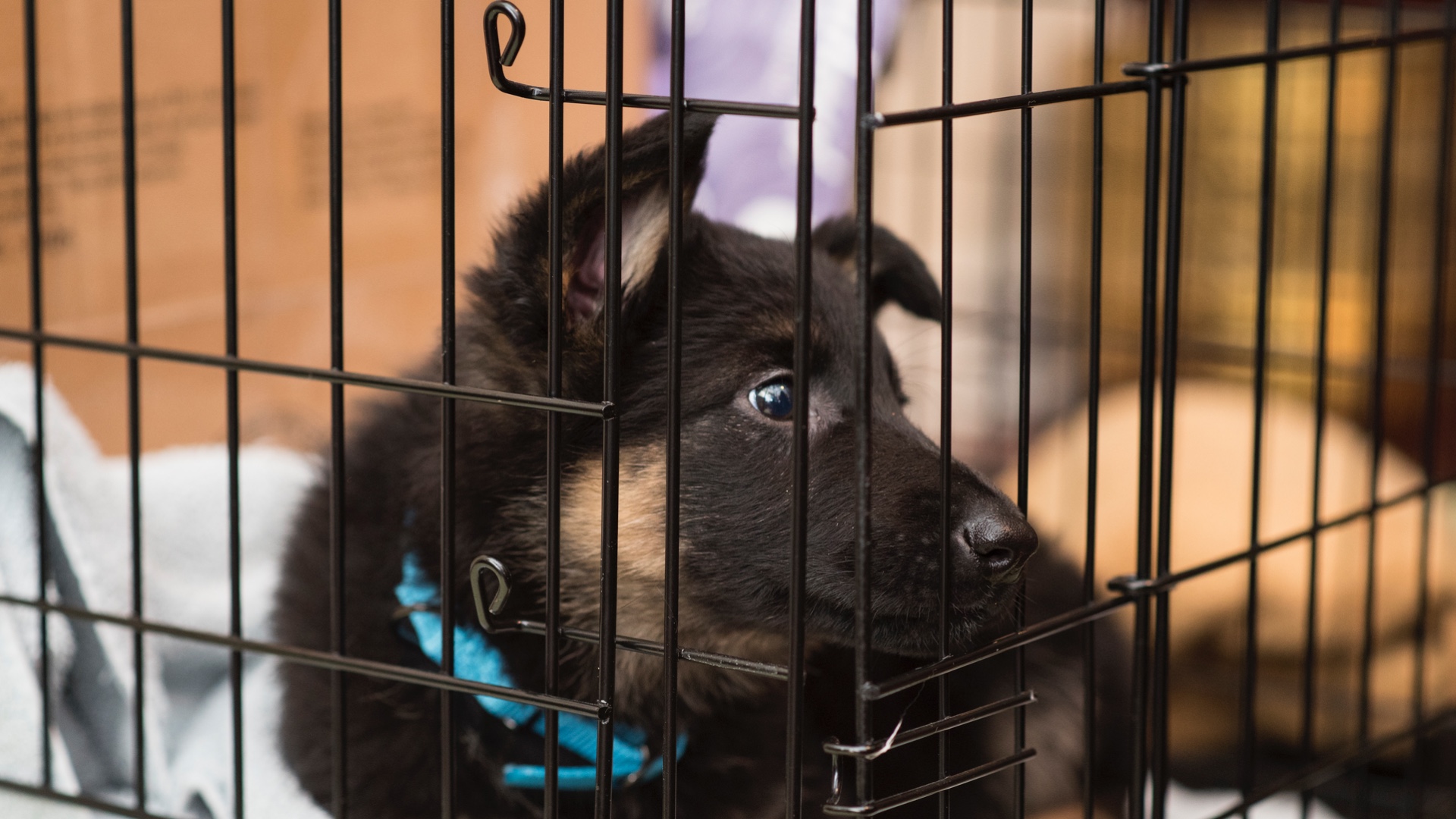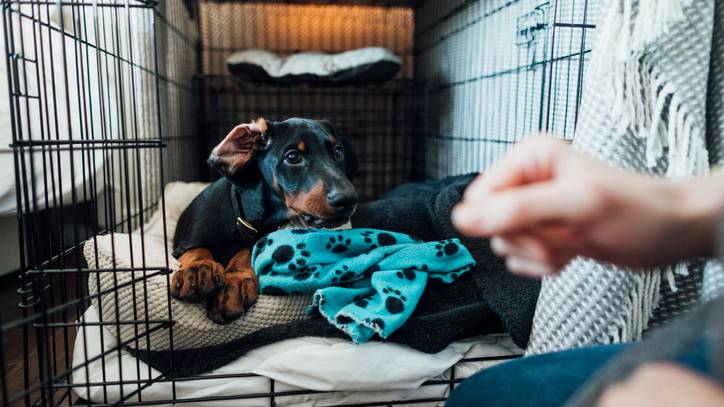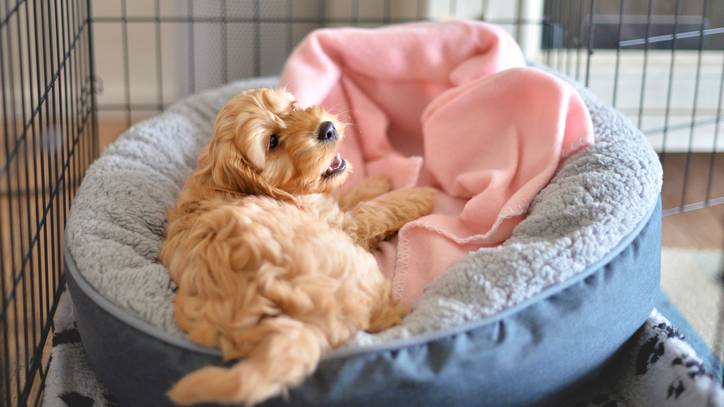How to stop your puppy crying in crate and help them settle
All the top tips on how to stop your puppy crying in a crate, and why pups do it

When your new puppy is unsettled all you want to know is how to stop your puppy crying in the crate. It takes time for your puppy to get used to it and stopping them from crying is a different, perhaps more stressful, challenge.
Investing in the best dog crate is all part of the process, and choosing the right one for your puppy is important.
However, it is not as much of a disaster as you may be telling yourself. There are lots of things you can do to help, including giving them one of the best puppy toys in their crate.
Our minds often jump to ‘our new puppy must be feeling sad and upset’ if they are crying and this can be deeply distressing for us in many ways. However, it is not as much of a disaster as you may be telling yourself.
Pups who have recently left their littermates will feel a little lost and lonely which is understandable and being in a crate may also be a further new experience for them, so a bit of whimpering and upset is perfectly normal behavior from them. This vocalization from them is their way of communicating with you, they are pack animals and social creatures after all. In time, you and the household members will become their new pack, but for now, the idea of being in a crate feeling isolated may not be something they agree with and therefore they’re trying to get your attention.
General advice on how to crate train a dog. is always useful to know but if you wish to know how to stop your puppy from crying in their crate for good read on so you can enjoy peaceful nights once again.
Why do puppies cry in their crate?
While you may be worrying that something is seriously wrong with your little one, crying in the crate is normal puppy behavior. Quite often, crying in the crate is a sign of separation anxiety in dogs as they're having to get used to being away from you and your other family members. It's especially hard on puppies, who may be sleeping alone for the first time since leaving their mother and siblings.
Get the best advice, tips and top tech for your beloved Pets
It's important to remember that puppies and dogs are highly social creatures and they hate being separated from the members of their pack - which includes you! "It's normal for puppies to cry when they go into their crate, but if you ignore it, it will stop and they will relax," explains professional dog trainer Adam Spivey.
Rest assured, with a few weeks of patience and perseverance when it comes to training, your puppy will soon learn that you always come back and this will help them to settle down.
How to stop your puppy from crying in their crate
Even with the best training practices, you may still find your puppy cries or whines to begin with during crate training. But the most important thing during this process is consistency.
Start the training early on to avoid your puppy picking up any bad habits or behaviors that will be difficult to curb when they get older, and try and remain patient as you continue training. Here are a few tips to help you get your puppy to stay quiet while they’re in their crate.
1. Pick the right size crate
We know, it seems obvious, but you’d be surprised how much crying comes from pet parents choosing a crate that’s too small. While they may be small, your puppy still needs enough room to stand up, turn around comfortably, and play with their toys (but not too big that they can use one end as a personal bathroom).
Many dog crates come with dividers that allow you to expand the size of the crate as your puppy grows. This can be a great way of both saving you money in the long run by ensuring you don’t have to purchase a new crate when your pup gets older, while also letting you create a space that feels both cozy and roomy.

2. Consider the location
Just like with your own home or apartment, when it comes to your puppy’s crate it’s all about location, location, location! It's really important that you don't put your puppy's crate too far away from where you and any other family members spend the bulk of your time. So, avoid the garage and basement and any other spaces that have a cold feel to them as this may cause your furbaby to feel especially isolated.
Instead, choose an area where you tend to spend a lot of time, like a living area as this will help your pup feel more secure. You might even want to consider investing in two crates and keeping one near the end of your bed at night so your puppy is still in the same room as you. Not only can this help your furkid feel less lonely, you’ll also be able to hear when they need to be let out to go to the toilet.
3. Get your puppy comfortable
According to dog trainer Heidi Atwood, you want to make the crate a wonderful place to be. "You can feed them some meals in the crate, hide pieces of kibble for them to discover or favorite toys, get them interested in going in on their own and checking it out," she says.
Make your pup's crate feel cozy and inviting so that your fur friend feels safe and secure. We recommend investing in one of the best dog beds and furnishing it with a nice, soft blanket. Donut-style options are great as they have higher sides than other designs and because they're often self-warming, they can help mimic the warmth of your pup's mother, which can bring them a lot of comfort.
After you've chosen a bed, consider popping in a few puppy toys so that your little furball has something to play with. "I have a freezer full of stuffed Kongs when I have a young puppy in my house, so that I can easily grab one and give them something very mentally stimulating, rewarding and fun. By the time they're done with the stuffed Kong, they're tired, and they will most likely have a nap," Atwood explains.
Make sure your puppy sees their crate as a happy and comfortable space to hang out. With that in mind, never use the crate as a form of punishment - you want every experience to be a positive one so that your puppy associates good things with being in their crate.

4. Give them plenty of exercise before crate time
A tired puppy is most definitely a sleepy puppy, so one of the most powerful weapons you have in your arsenal when it comes to getting your puppy to stop crying in their crate is playtime! The more energy your puppy burns before you pop them into their crate, the more likely they are to go straight into snooze land.
Once it’s time for them to be crated, give them a toy that can be filled with treats so that even when they’re settling down, they still have something to amuse themselves with until they fall asleep. We love the Kong puppy toy which is great for smearing with peanut butter or dog paste, and it's rubber, so it's a great teething toy too.
5. Factor in potty breaks
Just like a toddler, puppies can’t ‘hold it’ for anywhere near as long as adult humans and dogs can and crying is often a sign they need to go to the toilet, so you’ll want to factor in potty breaks.
So, how often should you get up during the night to let your puppy out for a toilet break? Well, a good way to think of things is to take the age of your puppy and add one. That means that a three-month-old puppy will be able to wait around four hours before they need to go to the toilet again, which means in an eight hour period, you'll be wanting to let them out twice.
However, when you’re learning how to potty train a puppy, there’s no such thing as too many breaks, so feel free to take them outside more until you get a sense of how often they need to go.

6. Ignore their whining
There's nothing more heartbreaking than having to stand in another room and listen to your puppy crying with no end in sight. It's incredibly hard as a pet parent to not want to rush in and soothe your stressed out little bundle of fur or let them out, but it's really important that you do resist the urge to do that, as it will only make things worse in the long run.
According to expert dog trainer Cesar Millan, you want to avoid giving your puppy any attention until they've gone quiet. "He has to calm surrender before he comes out of the crate," explains Millan. "Don't look at the puppy, just wait for the calm surrender. We want the crate to represent the highest level of relaxation....and we want the crate to represent a resting state."
What if your puppy still won’t stop crying?
Sometimes you can read and implement all the tips and tricks in the world and it still won't be enough to get your puppy to stop crying. If you're really having a hard time putting an end to this behavior, there are a couple of other things you can try.
First up, place a blanket over the crate. While this sounds simple, it can actually be really effective. A blanket will help make the inside of the crate that much darker, which can be very comforting for puppies.
There are also a range of the best puppy sleep aids on the market that can also be useful in helping your young one to settle. And remember, the most important thing is that your puppy knows that you’re in charge - if you don’t respond to every cry, they’ll soon get the message that whining isn’t an effective way to get what they want.
If you find that your puppy's crying continues weeks or months after you've exhausted all of the above suggestions, have a chat with your vet, who will be able to rule out any underlying health issues and offer advice and guidance on how best to proceed they may advise you seek out the help of a trainer or canine behaviorist too who also be able to you and your new doggo.
Enjoyed this piece and looking for more helpful training tips? Then be sure to check out our guide to how to stop a puppy biting, mouthing or nipping. You might also want to learn how to stop your dog barking in their crate.

Kathryn is a freelance writer who has been a member of the PetsRadar family since it launched in 2020. Highly experienced in her field, she's driven by a desire to provide pet parents with accurate, timely, and informative content that enables them to provide their fur friends with everything they need to thrive.
Kathryn works closely with vets and trainers to ensure all articles offer the most up-to-date information across a range of pet-related fields, from insights into health and behavior issues to tips on products and training.
When she’s not busy crafting the perfect sentence for her features, buying guides and news pieces, she can be found hanging out with her family (which includes one super sassy cat and a kitten), drinking copious amounts of Jasmine tea and reading all the books.
She has written for a range of publications, including Fit&Well, Top Ten Reviews, LiveScience, Goodto, and Product Hunt.
